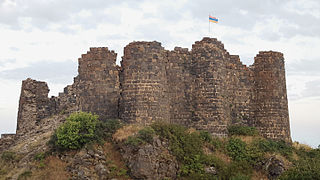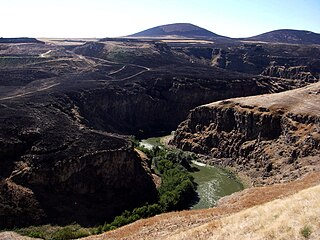
The Battle of Manzikert or Malazgirt was fought between the Byzantine Empire and the Seljuk Empire on 26 August 1071 near Manzikert, theme of Iberia. The decisive defeat of the Byzantine army and the capture of the Emperor Romanos IV Diogenes played an important role in undermining Byzantine authority in Anatolia and Armenia, and allowed for the gradual Turkification of Anatolia. Many Turks, travelling westward during the 11th century, saw the victory at Manzikert as an entrance to Asia Minor.
Pahlavuni was an Armenian noble family, a branch of the Kamsarakan, that rose to prominence in the late 10th century during the last years of the Bagratuni monarchy.

The Exarchate of Africa was a division of the Byzantine Empire around Carthage that encompassed its possessions on the Western Mediterranean. Ruled by an exarch (viceroy), it was established by the Emperor Maurice in 591 and survived until the Muslim conquest of the Maghreb in the late 7th century. It was, along with the Exarchate of Ravenna, one of two exarchates established following the western reconquests under Emperor Justinian I to administer the territories more effectively.
Ruben I,, also Roupen I or Rupen I, was the first lord of Armenian Cilicia. He declared the independence of Cilicia from the Byzantine Empire, thus formally founding the beginning of Armenian rule there. The Rubenid dynasty ruled Cilician Armenia until 1219.
Gagik II was the last Armenian king of the Bagratuni dynasty, ruling in Ani from 1042 to 1045.

Amberd is a 10th-century fortress located 2,300 meters (7,500 ft) above sea level, on the slopes of Mount Aragats at the confluence of the Arkashen and Amberd rivers in the province of Aragatsotn, Armenia. The name translates to "fortress in the clouds" in Armenian. It is also the name incorrectly attributed to Vahramashen Church, the 11th-century Armenian church near the castle. The village of Byurakan is 6.4 kilometres (4.0 mi) from the site of Amberd.

Byzantine Armenia, sometimes known as Western Armenia, is the name given to the parts of Kingdom of Armenia that became part of the Byzantine Empire. The size of the territory varied over time, depending on the degree of control the Byzantines had over Armenia.
The early military history of Armenia is defined by the situation of the Armenian Highland between the Hellenistic states, and later the Byzantine Empire, in the west and the Persian Empire to the east. The Kingdom of Armenia had a series of repeated struggles against Persia or Rome, followed by renewed conquests into either of the neighboring empires. The period after the Muslim conquests in the 7th century, up to the late 15th century, was mostly marked by invasions by other empires, such as by the successive Arab Caliphates, the Seljuk Empire, the Ilkhanate, the Timurid Empire and the Ak Koyunlu and Kara Koyunlu, amongst others. Some periods of greater military independence were, intermittently, achieved under the Bagratids and, albeit located outside the Armenian Highlands, the Armenian Kingdom of Cilicia.

The Kingdom of Georgia, also known as the Georgian Empire, was a medieval Eurasian monarchy that was founded in c. 1008 AD. It reached its Golden Age of political and economic strength during the reign of King David IV and Queen Tamar the Great from the 11th to 13th centuries. Georgia became one of the pre-eminent nations of the Christian East and its pan-Caucasian empire and network of tributaries stretching from Eastern Europe to Anatolia and northern frontiers of Iran, while also maintaining religious possessions abroad, such as the Monastery of the Cross in Jerusalem and the Monastery of Iviron in Greece. It was the principal historical precursor of present-day Georgia.

The Akhuryan or Arpachay is a river in the South Caucasus. It originates in Armenia and flows from Lake Arpi, along the closed border with Turkey, forming part of the geographic border between the two states, until it flows into the Aras as a left tributary near Bagaran. The Akhuryan is 186 km (116 mi) long, and has a 9,670 km2 (3,730 sq mi) drainage basin.
Vahram Pahlavuni was an Armenian military commander and official in Bagratuni Armenia. He was the head of the noble family of Pahlavuni, who held the hereditary title of sparapet (general-in-chief) in the Bagratuni kingdom of Armenia.
Battle of Vardanakert was fought between an Arab garrison and Armenians. The Armenian prince Smbat VI Bagratuni defeated the 5,000-strong Umayyad army from the garrison in Nakhichevan. Struck by a surprise attack, the remaining Arabs fled to the river Araxes and either drowned or froze to death. Smbat, chosen to rule by Byzantine commission, managed to re-conquer the majority of Armenia and drive the Arabs out of the country.
Trdat the Architect was the chief architect of the Bagratid kings of Armenia, and most notable for his design of the cathedral at Ani and his reconstruction of the dome of Hagia Sophia in Constantinople.

The Zakarids–Mkhargrdzeli, also Zakarids or Zakarians, also known by their Georgian name as Mkhargrdzeli (მხარგრძელი), were a noble Armenian–Georgian dynasty. Their name in Georgian, Mkhargrdzeli, or in Armenian: Երկայնաբազուկ, (Yerkaynbazuk) meant long-armed. A family legend says that this name was a reference to their Achaemenid ancestor Artaxerxes II the "Longarmed". According to Cyril Toumanoff / Encyclopædia Iranica, they were an offshoot of the Armenian Pahlavuni family. The Zakarians considered themselves Armenians.

Ani is a ruined medieval Armenian city now situated in Turkey's province of Kars, next to the closed border with Armenia.
Medieval Armenia refers to the history of Armenia during the Middle Ages. It follows Ancient Armenia and covers a period of approximately eight centuries, beginning with the Muslim conquest of Armenia in the 7th century. Key events during this period includes the rebirth of an Armenian Kingdom under the Bagratid dynasty, followed by the arrival of the Seljuk Turks. During this period, a portion of the Armenian people migrate to Cilicia to seek refuge from invasions, while the remnants in Eastern Armenia see the establishment of Zakarid Armenia under the Kingdom of Georgia. This period also marks the emergence of the royal dynasty in Artsakh.

The Byzantine–Sasanian War of 572–591 was a war fought between the Sasanian Empire of Persia and the Byzantine Empire. It was triggered by pro-Byzantine revolts in areas of the Caucasus under Persian hegemony, although other events also contributed to its outbreak. The fighting was largely confined to the southern Caucasus and Mesopotamia, although it also extended into eastern Anatolia, Syria, and northern Iran. It was part of an intense sequence of wars between these two empires which occupied the majority of the 6th and early 7th centuries. It was also the last of the many wars between them to follow a pattern in which fighting was largely confined to frontier provinces and neither side achieved any lasting occupation of enemy territory beyond this border zone. It preceded a much more wide-ranging and dramatic final conflict in the early 7th century.

Bagratid Armenia was an independent Armenian state established by Ashot I Bagratuni of the Bagratuni dynasty in the early 880s following nearly two centuries of foreign domination of Greater Armenia under Arab Umayyad and Abbasid rule. With each of the two contemporary powers in the region—the Abbasids and Byzantines—too preoccupied to concentrate their forces in subjugating the region, and with the dissipation of several of the Armenian nakharar noble families, Ashot succeeded in asserting himself as the leading figure of a movement to dislodge the Arabs from Armenia.

The Bagratuni or Bagratid dynasty was an Armenian royal dynasty which ruled the medieval Kingdom of Armenia from c. 885 until 1045. Originating as vassals of the Kingdom of Armenia of antiquity, they rose to become the most prominent Armenian noble family during the period of Arab rule in Armenia, eventually establishing their own independent kingdom. Their domain included regions of Armenia such as Shirak, Bagrevand, Kogovit, Syunik, Lori, Vaspurakan, Vanand and Taron. Many historians, such as Cyril Toumanoff, Nicholas Adontz and Ronald Suny, consider them to be the progenitors of the Georgian royal Bagrationi dynasty.

The Georgian–Seljuk wars, also known as Georgian Crusade, is a long series of battles and military clashes that took place from c. 1048 until 1213, between the Kingdom of Georgia and the different Seljuqid states that occupied most of Transcaucasia. The conflict is preceded by deadly raids in the Caucasus by the Turks in the 11th century, known in Georgian historiography as the Great Turkish Invasion.












